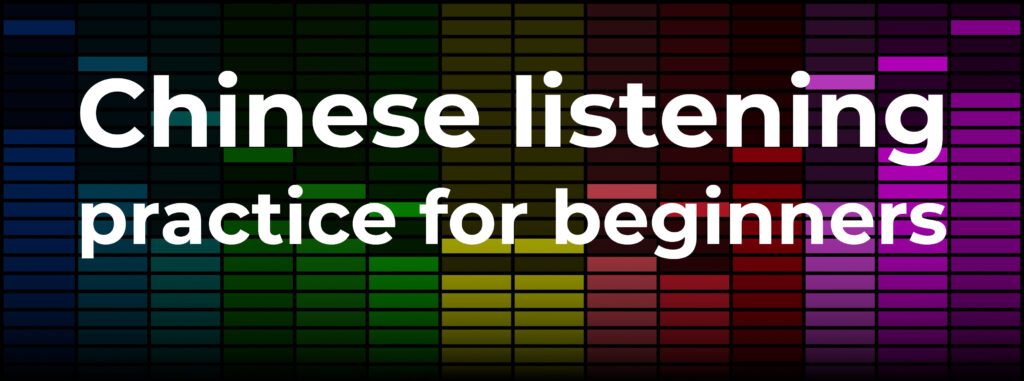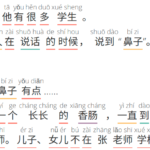 Learning to understand spoken Chinese is both hard and easy at the same time. It’s hard because it takes time, but it’s also easy because the solution is not complicated. To put this into concrete terms: engage in hundreds or thousands of hours of comprehensible input and you’ll reach your goal. Listening that much is difficult in the same way that walking a thousand miles is difficult; not because each step is hard or that walking is complicated, but because there are so many steps in total. Finding comprehensible input is mostly a problem for new learners, so let’s look at the best Chinese listening practice for beginners!
Learning to understand spoken Chinese is both hard and easy at the same time. It’s hard because it takes time, but it’s also easy because the solution is not complicated. To put this into concrete terms: engage in hundreds or thousands of hours of comprehensible input and you’ll reach your goal. Listening that much is difficult in the same way that walking a thousand miles is difficult; not because each step is hard or that walking is complicated, but because there are so many steps in total. Finding comprehensible input is mostly a problem for new learners, so let’s look at the best Chinese listening practice for beginners!
Tune in to the Hacking Chinese Podcast to listen to the related episode:
Available on Apple Podcasts, Google Podcasts, Overcast, Spotify, YouTube and many other platforms!
This article is rather long, so here’s an index to help you orient yourself and find what you’re after. If you want
Beginner Chinese listening practice: How to listen
- The 10 best free Chinese listening resources for beginner, intermediate and advanced learners
- Comprehensible input and beginner Chinese listening practice
- Scaffolding can make spoken Chinese comprehensible for beginners
- Finding suitable beginner Chinese listening practice materials
- Meaning-focused beginner Chinese listening practice
- Only listening to Chinese will improve your Chinese listening ability
- Beginner Chinese listening practice materials contain too much English
8 types of beginner Chinese listening practice: What to listen to
- Videos on YouTube and elsewhere
- Graded reader audio
- Textbook audio
- Text to speech
- Voice messaging
- Audio courses
- Reading apps with audio
- Vocabulary apps
The 10 best free Chinese listening resources for beginner, intermediate and advanced learners
In this article, I will discuss various types of resources for improving your listening ability in Chinese, including paid ones. I will also mention some specific resources, but if you’re after a list of my best recommendations, you should check this article instead, which also covers intermediate and advanced learners: The 10 best free Chinese listening resources for beginner, intermediate and advanced learners.
The 10 best free Chinese listening resources for beginner, intermediate and advanced learners
These two articles are different in a number of ways. In this article, I will discuss:
- Types of resources with examples, not just specific resources
- All resources, not just those that are available for free online
- Resources suitable for beginners, not all levels
Comprehensible input and beginner Chinese listening practice
The term “comprehensible input” is not hard to understand on a general level: it simply refers to Chinese listening hat you can make sense of. Typically, you can rely on contextual clues such as body language, images, listening or reading situation, and similar forms of scaffolding. This is crucial, because understanding spoken language without context is unnecessarily hard, especially for beginners.
In my article about the 10 best free Chinese listening resources for beginner, intermediate and advanced learners, you’ll notice that most of the beginner recommendations are actually videos, not podcasts or pure audio resources. This is because it’s extremely hard to make spoken Chinese comprehensible at a beginner level without relying on contextual clues. In a video, body language and images can be used to scaffold the listening practice, making it comprehensible.
How much you need to understand depends on the situation. If want to be able to pick up new words and grammar patterns simply by listening, you need to understand almost everything (98% or 99%), which gives you a decent chance of learning the occasional word you didn’t already know.
This is called extensive listening and is great. Unfortunately, as a beginner, it’s impossible to listen to hours and hours of Chinese where you understand almost everything. However, you should still make an effort to choose listening material where you understand as much as possible.
Comprehensible input (CI)is a very broad topic and I can only scrape on the surface here. If you want a more comprehensive overview of what CI is and how it can be used by both teachers and students of Chinese, please check out this three-part series written by Diane Neubauer:
An introduction to comprehension-based Chinese teaching and learning
Scaffolding can make spoken Chinese comprehensible for beginners
As mentioned above, there are ways of scaffolding your listening practice, which will help you understand spoken Chinese you would’t have been able to deal with unaided. Ideally, you should choose listening resources that already have scaffolding if you need it, such as an accompanying video.
However, there are things you can do yourself as a student. An example is simply to listen more than once. f you only understood the gist after listening once, you will probably understand a bit more after listening twice, and still a bit more after listening a third time.
Your patience permitting, you can keep doing this until listening one more time doesn’t lead to a better understanding of what you’re listening to. When you reach this, point you are also in a good position to determine if the material is too hard for you or not:
- If you reach this point and feel you have a good understanding of the material, save a few words here and there, a sentence pattern you haven’t heard before, you know that the material you’re listening to is appropriate.
- If you reach this point and still don’t understand most of what you’re listening to, it’s too hard for you at the moment. Save the audio somewhere and return to it a few weeks or months from now and try again.
Of course, you only need to do this with a snippet of audio to evaluate the rest! Figuring out that something is too hard after spending hours and hours on it isn’t very useful, after all.
Finding suitable beginner Chinese listening practice materials
As a beginner, you have no choice but to focus on spoken Chinese aimed at you specifically or at beginners like you in general. Anything else will contain so much new vocabulary and grammar that it will be far from comprehensible. When learning a closely related language, such as when learning German as a Swede, or Italian as a Spaniard, it’s possible to dive straight in and learn the language by watching TV series for example. This works because these languages share so much vocabulary and grammar that the input is almost comprehensible from the very start. This is not the case with Chinese!
As a beginner student of Chinese , you’re left with two good options:
- Chinese spoken to you specifically – This is where you speak Chinese with a friendly native speaker or a tutor who knows your level and is able to adjust their language. This is not easy to do well, so don’t expect random person who tries it for the first time to be very good at it. However, this type of individually tailored listening practice is great if you can get it, because what is comprehensible and interesting varies from person to person.
- Chinese produced for beginners in general – Most students don’t have access to private tutors or friendly native speakers who are willing to chat with them in easy Chinese all day long. This means that you also need to rely on listening materials aimed at beginners in general. Indeed, even if you do have a private tutor, you want to listen as much more than it’s realistic or practical to have a tutor around.
I’m not going to talk too much about private tutors in this article, because the problem there is usually that students can’t afford them, which I can’t do anything about. Of course, even if you have access to a tutor, you need to make sure you’re practising with them the right way, something I discussed here: Training your Chinese teacher, part 3: Listening ability.
Meaning-focused beginner Chinese listening practice
When listening, your goal should be to figure out what the person is saying. This might sound obvious, but in classrooms all over the world, a lot of listening practice isn’t actually maning-focused. For example, if you play the audio to a text you just read, you already know what it’s about, so the listening practice is in effect spoiled (I wrote more about this here Listen before you read: Improve your listening ability).
Another example is if your teacher provides five example sentences for a grammar pattern you just learnt, when the goal is actually to learn the grammar pattern, not understand the meaning behind each example. Yet another example is if listen to your classmate reading their part of a dialogue you both have in front of you.
Meaning-focused input is one of Paul Nation’s four strands, a framework you can use to analyse and balance your Chinese learning. For listening practice to count as meaning-focused, it also needs to be comprehensible, so if you need to look up every other word, it doesn’t count. For more about meaning-focused input, check the about the four strands!
Analyse and balance your Chinese learning with Paul Nation’s four strands
Only listening to Chinese will improve your Chinese listening ability
Another important thing to keep in mind when listening is that only listening to Chinese will improve your Chinese listening ability. This might also be obvious, but if you check beginner listening materials online, you will notice that most of the podcasts and other resources make heavy use of English.
In some cases, this is extreme, so you might have a ten-minute podcast episode where only a single minute is in Chinese, usually a short, scripted dialogue that is repeated a few times for a total of one minute The rest of the episode consists of well-meaning hosts explaining the Chinese to you in English with only occasional words in Chinese. This does not count as meaning-focused listening and is mostly a waste of time.
Beginner Chinese listening practice materials contain too much English
The reason they use English is that it’s terribly hard to create content for beginners using only Chinese. While it’s possible to use images, body language and other clever scaffolding, explaining something in English is easier. However, this makes your listening practice inefficient! If all your listening were like the example episode mentioned above, you’d have to spend a thousand hours to get to a hundred hours of meaning-focused listening!
You’re much better off with only a sprinkle of English or no English at all. Another option is to separate the English and the Chinese so you can use the English for help and guidance once, then listen to only the Chinese bits.
In my list of recommended listening resources, I tried very hard to stay away from resources that used a lot of English, bu even though I checked every single beginner resource I could find, it was hard to find even a handful that did’t use excessive English!
8 types of beginner Chinese listening practice: What to listen to
With that said, let’s have a look at some ways of finding listening resources. Remember, my goal here is not to just list resources, I already did that in the other article, but rather to go through a number of different types of resources and discuss how they can be used by beginners.
Beginner Chinese listening practice #1: Videos on YouTube and elsewhere
 As discussed above, if you’re a complete beginner and want to kickstart your listening ability, you almost have to rely on video content, because it’s simply not possible to provide meaning-focused, comprehensible input when you know less than a hundred words without heavy use of scaffolding such as images and body language. Even with these aids, it’s still hard, which is why so few people are creating this type of videos.
As discussed above, if you’re a complete beginner and want to kickstart your listening ability, you almost have to rely on video content, because it’s simply not possible to provide meaning-focused, comprehensible input when you know less than a hundred words without heavy use of scaffolding such as images and body language. Even with these aids, it’s still hard, which is why so few people are creating this type of videos.
Recommended videos for beginner Chinese listening practice
Here are my top three recommendations, all from my best listening resources article. The links take you to my introduction of each resource, where you can also find a link directly to the resource in question:
These are great resources for beginners! Once you have watched an episode a few times and think you know what’s going on, make sure to download the audio so you can listen while going about your day.
Beginner Chinese listening practice #2: Graded reader audio
 Graded readers are books written with a specific level in mind, often measured in characters or words. Most of them also come with audio recordings, which is what we are interested in here.
Graded readers are books written with a specific level in mind, often measured in characters or words. Most of them also come with audio recordings, which is what we are interested in here.
If you are interested in purchasing any of these books with the intent to use them for listening practice, make sure you will get access to audio as well! Some specific books might not have audio, and sometimes a certain version doesn’t include the audio. I won’t repeat this for every resource I recommend below, but please make sure the product you buy includes audio recordings!
Graded readers typically start at 300 words, but there are easier ones starting at 150 words. This means that they will be a bit tricky if you started learning Chinese last week, but as soon as you have a hundred words or so under your belt, you should be ready! Indeed, a good goal for a beginner is to get to a level where you can listen to the easiest graded readers and understand them with some scaffolding.
The main advantage with graded readers is that they much, much longer than the other resources I recommend here, while still staying at the same level of difficulty. This means that you can listen for hours without dying of boredom, which is great! Bite-sized learning is good sometimes, but it’ can be very tedious to listen to hundreds of one-minute snippets too. Indeed, you will find that listening to this type of content becomes easier the further into the story you get, whereas in a textbook, the Chinese gets harder faster than you improve.
Recommended graded readers for beginner Chinese listening practice
- Mandarin Companion, especially the breakthrough level at only 150 characters. You can read my review of all Mandarin Compnaion books here.
- Chinese Breeze is another series of books, starting at 300 words.
- Sinolingua Rainbow Bridge, starting at 150 words, simplified only.
- For more graded readers, check this post by Diane Neubauer, even though not all of these have audio.
Beginner Chinese listening practice #3: Textbook audio
You might have sighed when you saw “textbook” in the heading above, but unless you’re familiar with my way of using textbooks, don’t write them off just yet. Textbooks are written with beginners in mind, and entry-level textbooks are written for zero beginners. This means that they contain texts and dialogues that are as easy as possible and don’t require any prior knowledge to make sense of.
Great, but everybody knows that already.
What I suggest that is that you use more than one textbook. If you listen to everything in chapter 1-5 in five different textbooks, you can be relatively sure that the listening will become easier and easier for each textbook you cover. You will also hear different native speakers saying the same basic words and phrases over and over. While you can buy all these textbooks, you can also find many of them online.
Recommended textbooks for beginner Chinese listening practice
- Integrated Chinese
- New Chinese Practical Reader
- A Course in Contemporary Chinese
- Practical Audio-Visual Chinese
- Easy Steps to Chinese
Beginner Chinese listening practice #4: Text to speech
Text to speech, or speech synthetisation, has improved rapidly in the past decade. When I started learning Chinese in 2007, the best text-to-speech services were horrible. They produced spoken Mandarin that was understandable, but contained so many errors that it would be a crime to use them for language-learning purposes.
This is not true anymore. Even though I strongly prefer to listen to a real native speaker, text-to-speech is good enough to be used when you don’t have access to audio recorded by a human. Yes, it will be a bit weird sometimes, but probably not more often than a human speaker. Text to speech works particularly well with longer chunks (words or preferably sentences), so be careful with individual syllables.
You can use text-to-speech services (TTS) in a variety of ways, most importantly for turning any text into a listening opportunity. There are plenty of built-in TTSK functions on smartphones and computers, along with dedicated apps and browser extensions. I plan to cover these in a separate article, but for now, simply search for the system you use and “text to speech” or “TTS”, and you’ll find plenty of options. Next time you receive an email or text message in Chinese, why not listen to it before you read it?
Beginner Chinese listening practice #5: Voice messaging
I said I wouldn’t cover interacting with a friendly native speaker or tutor, but I feel I have to mention voice messaging anyway, simply because it isn’t something most students or indeed teachers think about. By using the voice messaging function available in most chat services, you can send and receive spoken audio that you can then listen to and respond to at your leisure.
You can then listen to these messages, or indeed whole conversations, again whenever you want! While it might be a bit technically tricky, you could in theory also extract this audio and put it in your audio library along with all the other good listening content you’ve found in this article!
I won’t go into details about voice messaging and why it’s awesome, because I have already covered that in another article: Using voice messaging as a stepping stone to Chinese conversations.
Using voice messaging as a stepping stone to Chinese conversations
Beginner Chinese listening practice #6: Audio courses
There are a range of courses for learning Chinese where you might be encouraged to look at written notes, but where the majority of the content is meant to be listened to. These vary from low-quality Learn Chinese in Your Car types of courses sot more carefully structured learning materials.
Depending on what course you choose, these courses can suffer from the same problem as podcasts for beginners, namely that they teach you mainly by explaining Chinese words and grammar in English. This is, as I have already pointed out, not doing much for your Chinese listening ability.
I have yet to review different audio courses, let alone make a comprehensible overview of them, but here are a few alternatives that I know of. If you have personal experience of these or other audio courses, please leave a comment and let me know what you thought of them! Note that these are all paid resources, sometimes rather pricey too.
Beginner Chinese listening practice #7: Reading apps with audio
 There are many apps that aim to present you with reading materials on your level, and most of these also have audio, although sometimes synthesised. While these apps don’t control difficult as carefully as graded readers typically do, they can still be useful for beginner listening practice.
There are many apps that aim to present you with reading materials on your level, and most of these also have audio, although sometimes synthesised. While these apps don’t control difficult as carefully as graded readers typically do, they can still be useful for beginner listening practice.
Another difference between these apps and graded readers is that they often present bite-sized content. As I pointed out above for graded readers, long-form content is usually good, but it can sometimes be nice to start listening to something you know you can finish in fifteen minutes, even if you need to listen more than once!
Recommended reading apps with audio for beginner Chinese listening practice
- DuChinese (smooth interface with free and paid content; use code HACKINGCHINESE for 10% off)
- The Chairman’s Bao (focusing on easy-to-read news)
- WordSwing (text adventure games at a slightly higher level; Escape! is free to play, learn more here).
Beginner Chinese listening practice #8: Vocabulary apps
 These apps don’t present you with listening material as such, but are instead focused on teaching you vocabulary and phrases. Some of them have audio recorded by native speakers, although this is pretty rare. In Pleco, for example, you can get this as a paid add on, whereas it’s included in Skritter’s subscription. In Anki, there are various free text-to-speech engines to choose from.
These apps don’t present you with listening material as such, but are instead focused on teaching you vocabulary and phrases. Some of them have audio recorded by native speakers, although this is pretty rare. In Pleco, for example, you can get this as a paid add on, whereas it’s included in Skritter’s subscription. In Anki, there are various free text-to-speech engines to choose from.
Of course, these apps should never make up the bulk of your listening practice, but since you probably want to use some kind of spaced repetition software to build your vocabulary anyway, you might as well use an app that allows you to practise listening as well.
These apps can also be useful for building familiarity with the basic sounds and tones of Mandarin. For example, I provide audio flashcards with my pronunciation course so you can practise your ability to differentiate initials finals and tones. You can also build your own audio flashcards for free with text-to-speech in Anki, something I covered in detail here: Free and easy audio flashcards for Chinese dictation practice with Anki.
Recommended vocabulary apps for beginner Chinese listening practice
- ChineseSkill (similar to Duolingo, but better suited to Chinese)
- Pleco (flashcards and human audio are paid add-ons)
- Anki (free and very flexible; check my article below)
- Skritter (has a lot of manually recorded audio; read my review here)
Free and easy audio flashcards for Chinese dictation practice with Anki
Conclusion: As a beginner, listen to as much Chinese as you can at your current level
How much you improve your listening ability depends largely how much time you spend, how actively you engage with the content and how much you are able to understand. I have discussed all these things in great detail in other articles, but the main goal in this article was to show you what types of listening practice you should focus on as a beginner.
Actually, most of what I say here is true for intermediate and advanced learners as well, it’s just that the more you learn, the easier it becomes to find suitable listening resources. As a beginner, you don’t have the luxury to listen to Chinese that is both comprehensible and interesting, but this becomes possible at an intermediate level! Of course, you should still choose the most interesting listening content you can find, I’m just saying that with a vocabulary of one hundred words, you’re not going to be able to find listening material that you would find truly interesting if it were in your native language!
That’s it, for now at least. I’ve done my best to provide you with beginner-friendly listening materials. What’s your favourite? Do you maybe know of a resource I have overlooked? Please leave a comment below!
This article has a companion article about reading practice for beginners, check it out here: The best Chinese reading practice for beginners
https://www.hackingchinese.com/best-chinese-reading-practice-for-beginners/


4 comments
As a “my first reader” I can recommend “23 cats”, a Dr. Seuss style story using just 100 words. The audio can be downloaded without buying the book.
https://imagin8press.com/books/twenty-three-cats-%E4%BA%8C%E5%8D%81%E4%B8%89%E5%8F%AA%E7%8C%AB/
Great, thank you for sharing! I didn’t know you could download the audio without buying the book, but this seems to be fairly common among publishers. My guess is that most customers view the book as the main product and then audio is just a bonus, and so the publisher saves a lot of hassle by offering it as a free download. I was familiar with the book, although I haven’t read it, through Diane Neubauer’s review of lots low-level graded readers here.
Olle, wow, this is fantastic! Thank you so much!!
No problem, glad you liked it!